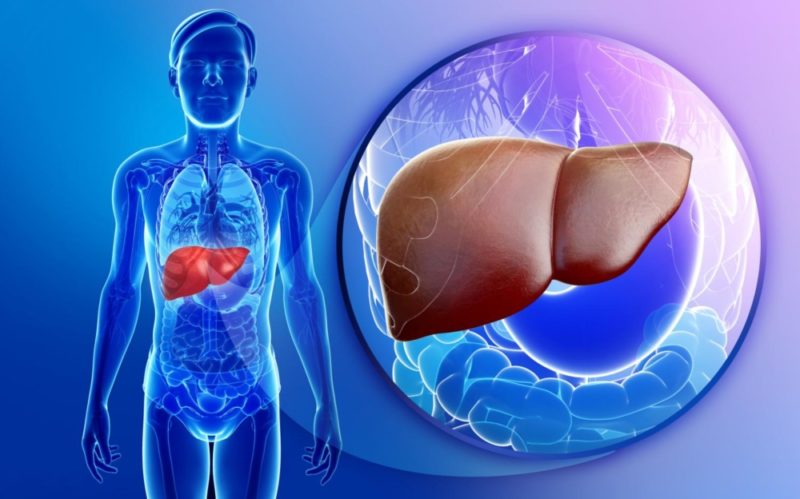The liver is an important organ that ensures the vital activity of the whole organism by participating in the digestion, metabolism, and also in the removal of metabolic products. Damage to the liver of any etiology negatively affects the work of the whole organism. One of these pathologies is chronic hepatitis.
Material Content:
What is chronic hepatitis, what is dangerous
A characteristic feature of the disease is the presence of inflammation, but with the preservation of lobules in their anatomical structure. A chronic form of pathology is established in the case of the duration of the disease - for six months or more. The presence of a certain amount of fibrosis and necrotic inclusions in the liver tissue determines the clinical symptoms of the disease.
Inadequate treatment or its absence contributes to the rapid progression of the disease with the degeneration of the pathology into cirrhosis or cancer. Early diagnosis of hepatitis, its chronic form, and timely therapy make it possible to slow down the process with its transfer to a stable remission.
Types of disease
Of all the varieties of pathologies that cause liver damage, chronic viral hepatitis A, B, C, D represents the largest group. It, depending on the influence of various factors on its occurrence, has specific varieties.
Each type of pathology corresponds to a certain type of pathogen with its own structural features, penetration pathways, as well as clinical manifestations.
The main differences between different types of viral liver damage are:
- type A - in clinical practice is called Botkin's disease. Infection occurs through the digestive tract. The clinical manifestations of the infection are pronounced. Transition to a chronic form is rare. The disease leaves a lasting immunity;
- type B - the transmission of the virus in most cases is carried out from a sick patient or virus carrier, since the pathogen is present in all physiological environments of the body. The disease proceeds with severe clinical manifestations, both in acute and in chronic form;
- type C is the most dangerous type of hepatitis. The penetration of an infectious agent into the body occurs through the blood. The source of the disease is a sick patient. Up to 80% of cases of the acute period of the disease progresses latently. Only with the transition of hepatitis to a chronic form does symptoms appear. The aggressiveness of the pathology leads to irreversible changes in the liver with their transition to cirrhosis;
- type D - reproduction and infection of the body is impossible without the presence of hepatitis B virus, which significantly worsens the clinic and further prognosis. The transmission of the virus is through the blood. The course of hepatitis D occurs in most cases in the form of a chronic course with a transition to liver cirrhosis.
Viral hepatitis is detected in the bulk of patients, the incidence of which reaches 70% of all diagnosed liver ailments.
Causes of the virus
The following causes most often cause chronic hepatitis:
- previously transferred hepatitis type B, C and D, more rarely type A;
- intoxication of the body with various substances (medicinal, toxic, alcohol abuse);
- autoimmune processes;
- infectious diseases;
- pathological processes in the liver, provoking disturbances in its cellular structure.
In addition to the main reasons leading to the development of chronic hepatitis, there are a number of factors contributing to this process.
The most significant of them are:
- work in hazardous production conditions;
- chronic alcoholism;
- unbalanced nutrition;
- helminthic infestations;
- non-observance of personal hygiene.
Any of these reasons can provoke the formation of a chronic disease, the course of which will largely depend on the state of the body's defenses, early or late diagnosis and complex treatment.
Forms and classification
Classification of chronic hepatitis is carried out according to several aspects, among which there are:
by etiological factor
- viral hepatitis - chronic viral hepatitis B, C, D, A;
- autoimmune;
- medication;
- alcoholic;
- toxic;
- cryptogenic hepatitis of unknown etiology.
According to morphological characteristics
- active (aggressive) hepatitis with varying degrees of activity - the course of the process in the form of a necrotic form with a violation of bile stasis;
- persistent chronic hepatitis;
- lobular;
with the flow
- exacerbation;
- remission;
in form
- acute;
- chronic hepatitis.
Thus, practicing specialists classify chronic hepatitis, since this classification is the most convenient in medical practice.
Symptoms and signs of chronic hepatitis
The course and symptoms of hepatitis will largely depend on the form of pathology, state of immunity, and concomitant diseases of the patient. The course of persistent hepatitis is manifested by a low activity of the process.
Sometimes the clinic of the disease is practically absent or is manifested by the following symptoms:
- slight soreness in the right hypochondrium, sometimes nausea, bitterness in the mouth that occurs when taking alcohol, eating errors (eating fatty foods);
- with a manual examination of the abdominal cavity, a slightly enlarged liver is located, located at the edge of the costal arch.
With the exception of provoking factors, the patient's health remains normal, and full capacity for work.
The clinical picture with an active progressive form of chronic hepatitis will be very pronounced and will be manifested by the following symptoms:
- the appearance of dyspepsia in the form of nausea, vomiting, bloating, disruption of the intestines, loss of appetite;
- fatigue, weakness with any, even insignificant physical stress, reduced ability to work;
- sleep disturbance;
- weight loss;
- periodic headaches.
Against the background of general intoxication of the body, signs of liver failure appear:
- jaundice;
- itchy skin and the appearance of "spider veins";
- temperature rise;
- the appearance of ascites, that is, fluid in the abdominal cavity;
- phenomena of hemorrhagic diathesis;
- severe pain in the right half of the abdomen in its upper region.
The objective manifestations of active hepatitis are supplemented by a diffusely enlarged, painful and dense texture of the liver protruding from under the costal arch. Against this background, an increase in the size of the spleen and regional lymph nodes progresses.
The symptoms of chronic viral hepatitis D are even more severe, in which liver failure becomes more pronounced. Against this background, pathological disorders in the kidneys, joints, and lungs are traced.
With autoimmune hepatitis, clinical symptoms are more often observed in young women, manifesting in the following form:
- weakness;
- decreased performance;
- fast fatiguability;
- pains of a pulling character on the right.
Against this background, an increase in temperature, manifestations of dyspepsia in the form of nausea, vomiting, flatulence, and stool disorders can be noted. Often, pathological changes affect the lungs, thyroid gland, and cardiovascular system.
For chronic hepatitis C, the presence of many nonspecific symptoms is typical, which can simulate obstructive jaundice or the development of an acute process.
Important! The appearance of weakness, malaise, dyspepsia, discomfort in the right hypochondrium requires a mandatory examination by a therapist or gastroenterologist with laboratory monitoring to exclude liver disease.
Diagnosis
Diagnosis of hepatitis begins with a medical history, examination of the patient with an assessment of his objective data and a preliminary diagnosis.
Further diagnostics are carried out by laboratory and instrumental methods of research:
- blood, urine for a general analysis;
- blood chemistry;
- blood for markers of viral hepatitis;
- Ultrasound
- rheohepatography;
- according to the indications of liver MRI;
- According to indications, a biopsy of the liver tissue for histological examination.
After a full examination of the patient, a final diagnosis is made and treatment is prescribed.
Virus treatment
Treatment of chronic hepatitis is carried out comprehensively and includes the following measures:
- exclusion of any loads;
- bed or half bed mode;
- dieting;
- symptomatic therapy to relieve symptoms of intoxication;
- vitamin therapy;
- taking hepatoprotectors, immunomodulators;
- injections of interferons.
Treatment is carried out in a hospital taking into account the form of pathologists and its manifestations. Therapy is long lasting. During the treatment process, a laboratory study in dynamics is mandatory to monitor the effectiveness of the treatment.
With autoimmune chronic hepatitis, treatment with hormonal drugs gives a positive result. The dose for admission is selected taking into account the activity of the process and the individual characteristics of the body. In some cases, in the absence of the effect of conservative therapy, a liver transplant is recommended.
Diet for the disease
To obtain a positive result from treatment, maximum unloading of the liver is necessary, which is achieved by prescribing diet No. 5. It includes a list of products that give a balanced combination of proteins, fats, carbohydrates.
It is recommended to exclude from the diet of a patient suffering from chronic hepatitis:
- fatty meats and fish;
- any fried, smoked and canned foods;
- various pickles and marinades;
- mushrooms of any kind;
- white cabbage, onion, garlic, radish, radish;
- strong black tea and coffee;
- colored carbonated and alcoholic drinks.
Food should be chopped and steamed as much as possible, and it should be taken fractionally, up to 5-6 times a day in small portions.
Diet table No. 5 recommends the following products for use:
- eggs
- buckwheat;
- low fat cottage cheese;
- lean beef or veal;
- boiled vegetables - pumpkin, beets, carrots;
- dairy products of low fat content;
- honey;
- vegetable oils.
Be sure to comply with the drinking regime in the form of water up to 1.5 liters per day with the addition of citrus fruit juice.
Preventative measures
To avoid liver damage and the development of chronic hepatitis, it is necessary to observe preventive measures, which include:
- the use of disposable syringes for injection;
- the use of protective contraceptives in intimate relationships;
- systematic vaccination;
- exclusion from the use of alcoholic beverages;
- regular preventive examinations with the delivery of laboratory tests;
- complete and balanced nutrition.
Compliance with preventive measures, the implementation of all the doctor's recommendations for the prevention and treatment of chronic hepatitis will help to avoid the development of severe liver pathology, which significantly reduces not only the quality of life, but also the ability to work.




















